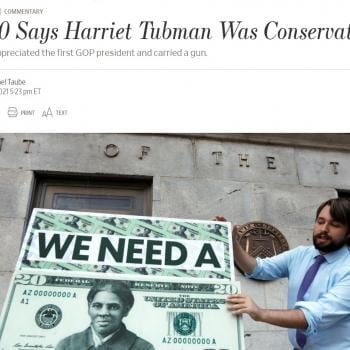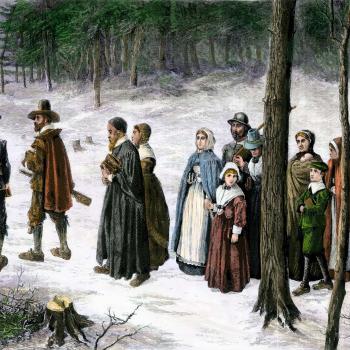When I first started having questions about some of the beliefs I was raised with, I delved into the history of these beliefs. I had thought that Christians had always been Young Earth Creationists, had always believed in Dispensationalist Premillennialism and a Pretribulation rapture, and had always spoken of “inviting Jesus into their hearts” through praying the sinners’ prayer. Imagine my surprise when I learned that all of these beliefs were less than two hundred years old. I was completely shocked.
I’m going to share with you what I learned about Dispensationalist Premillennialism during these years, but be aware that what I’m offering is a relatively simplified version of what happened and how these ideas developed.
Originally, Christians were Amillennialists. They believed that Christ might return any day, and that his return would be followed by the final judgment of all humans. Until Christ returned, they believed that they were to go about their lives living as Christ had commanded. As the year 1000 approached, many Christians were convinced that Christ would return on that date, but he did not. Even after the Protestant Reformation, Protestants held these same Amillennial views.
Postmillennialism actually originated in the early 1700s and then gained popularity during the First Great Awakening of the 1740s (in the United States) through the preaching of Jonathan Edwards. There was a great deal of excitement during the Awakening, which was a time of spiritual revival, and a great deal of optimism, making the atmosphere perfect for the embracing of Postmillennialism, with its belief that Christians could bring about the Millennium and ultimately Christ’s second coming by spreading the gospel and bettering the world.
Over time, three different strands of Postmillennialism developed. Classic Postmillennialism focuses on bringing the Millennium about by spreading the gospel, Liberal Postmillennialism focuses on bringing the Millennium about by bettering the world, and Theonomic Postmillennialism, which is the most recent, focuses on bringing about the Millennium through the imposition of Old Testament Law.
The optimism of the new American nation and the evangelical revivalism of the First Great Awakening (1740s) and Second Great Awakening (1800-1840) made it the perfect place for Postmillennialism to take root. During the Antebellum period American evangelicals sought to convert the world through tract and missions societies and better the world through reform movements.
By the late nineteenth century, though, the theological landscape was beginning to change as the evangelicals who had been so united began to split in two. The more liberal evangelicals embraced new theological ideas such as Biblical criticism coming from Europe and turned to the “social gospel,” placing more emphasis on improving the world than on saving souls. These evangelicals became what we term “mainline Protestants.”
Meanwhile, conservative evangelicals balked, shocked at the direction their brethren were taking. Fundamentalism emerged at this time in response to these new theological trends. The idea these conservative evangelicals had was to get back to the “fundamentals” of the faith, which included the inspiration and inerrancy of the Bible first and foremost.
Shortly before this period, John Nelson Darby had traveled across the United States teaching his new Dispensationalist theology. Influenced by his ideas and embracing the inspiration and inerrancy of the Bible, Fundamentalists set about interpreting both Old Testament prophecy and the book of Revelation in huge “prophecy conferences” held in the late nineteenth century and attended by hundreds or even thousands of fundamentalist pastors and theologians. During this period, the idea of a Pretribulational rapture and the coming Tribulation were invented, the details of the Tribulation were details hashed out, Darby’s concept of Dispensations was embraced, and Premillennialism as we know it was born.
Dispensational Premillennialism, complete with its belief in the Tribulation and a belief in a Pretribulational rapture, were popularized in the early twentieth century through the Scofield Reference Bible and numerous Fundamentalist newsletters, radio shows, and Bible colleges. Dispensational Premillennialism was aided by the fact that mainline Protestants’ Postmillennialist beliefs seemed directly contradicted by WWI and the Great Depression. While Postmillennialist beliefs have made a bit of a come back today, adherence to Premillennialism remains strong.
It should be remembered that there was always at least some division among Fundamentalist Christians. Seventh Day Adventists, along with some others, accepted the idea of a coming Tribulation but rejected the Pretribulation rapture as a heresy. Similarly, some Premillennialists emphasized Dispensationalism more than others. So there is variation in these ideas as well as unity.
Modern fundamentalists and evangelicals both trace their roots back to the Fundamentalists of the late nineteenth century prophecy conferences and the early twentieth century Fundamentalist radio shows and Bible colleges. This united coalition split during WWII into two factions, those who wanted to remain separate from the world in order to remain pure and those who wanted to engage the world in order to gain converts. For a time, these more engaged fundamentalists, led by Billy Graham, were called “neo-evangelicals,” but the “neo” was eventually dropped. This common lineage is why you’ll find that except for the most progressive evangelicals, who have switched millennial camps, both evangelicals and fundamentalists share the same eschatology (which is a fancy word for beliefs about the end times).
It seems like once a generation or so fundamentalists and evangelicals come out with a new book or series popularizing Dispensational Premillennialism. Hal Lindsey’s Late Great Planet Earth was actually the top selling book of the 1970s, and no one who lived through the 1990s could miss Tim LaHaye’s Left Behind series and the popularity that surrounded them. Combined with notes in reference Bibles and the sermons they hear in church, these books help keep end times speculation alive and well in the minds of both evangelicals and fundamentalists.
When I finished figuring this out as part of my efforts to dig into the history of the beliefs I had been raised with, I was highly disillusioned. My parents and the church I grew up in had taught me all of these ideas as gospel truth, and I had never had even an inkling that they were so new. This not only made me reexamine what I believed about the end times but also helped throw the rest of what I’d been taught was gospel truth into question as well. And, well, that journey landed me here.
Also in this series:
Part I – The Millennium, Tribulation, and Rapture
Part II – Social Justice, Dominionism, and the Culture Wars
Part IV – The Tribulation in Detail
Part V – Signs, Prophesies, and Current Events
Part VII: Dispensational Premillennialism’s Recent Origins














